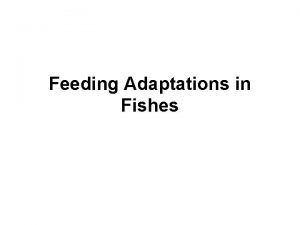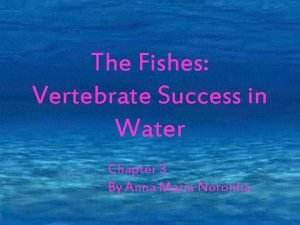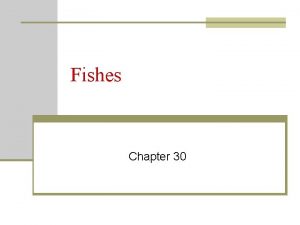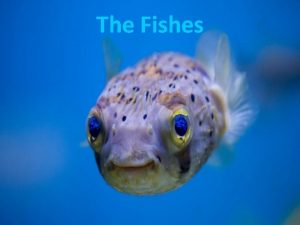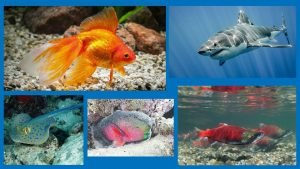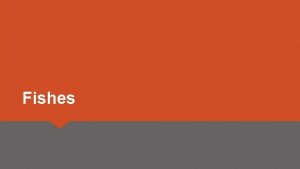Fish Feeding Periodicity in Fishes Dr Amrutha Gopan














- Slides: 14

Fish Feeding Periodicity in Fishes Dr. Amrutha Gopan Assistant Professor School of Fisheries Centurion University of Technology and Management Odisha

Season Feeding periodicity is related to water temperature and metabolic rate. Annual cycle of temperature variation is more pronounced in temperate waters, where feeding frequency is more in summer.

Migratory activity cycle and reproductive Fishes which undertake migration for breeding eat intensively and accumulate reserve food material.

Amount of food consumed daily It depends mainly on the quantity of food and size of fish.

Quantity of food In tropical waters, temperature and metabolic rate being higher the food requirement is also higher. The fishes living in temperate waters feed on small quantity of food as the temperature and metabolic activity are also lower e. g. salmon.

Size of fish Small fishes consume more food. For example, small fishes which weigh about 2 -5 grams consume 6 -10% of their body weight per day, whereas bigger fishes which weigh about 30 gm or more feed on 2 -3% of their body weight per day. During spawning season, most of the fishes stop feeding due to the enlargement of gonads.

Food and Feeding Habits of Fin Fishes in Indian Water

Indian Oil Sardine (Sardinella longiceps) It is predominantly a phytoplankton feeder -Fragillaria oceanica, Coscinodiscus, Thallassiothrix and Pleurosigma. They may also feed on copepods, dinoflagellates, ostracods, larval prawn, larval bivalves, fish eggs. Lesser sardines It feed on a variety of phytoplankton and zooplankton.

Mackerel • Mackerels are plankton feeders, feeding to a greater extent on zooplankton and to a lesser extent on the phytoplankton. • Adults feed on larval shrimps and fish. Tunas are carnivores and the major food items include crustaceans cephalopods (juveniles and adults), eggs, larvae and juveniles of small fishes. Carangid fishes It feed mostly on fishes like anchovies, sardines, silver bellies, ’squids, cuttlefishes shrimps and crabs. The young ones feed mostly on prawns, squids and anchovies.

Ribbon fishes (Trichiurus lepturus) All the ribbon fish species are highly carnivorous, predatory and voracious feeders. They prefer small and medium sized fishes and shrimps. Bombay-Duck (Harpadon nehereus) • It is a carnivorous fish Silver belly • mainly zooplankton feeders. Sciaenids • They are carnivores and active predators.

Lizard fishes The young ones feed chiefly crustaceans like lucifer, acetes, mysis and fishes such as anchovies and silver bellies. Adult feed on crustaceans such as copepods. Pomfrets Young ones feed on copepods, ostracods, amphipods, larval stages of squilla, lucifer. Adult feed on crustaceans such as copepods (Oithona spp. , Euterpina spp. , and Eucalanus spp. ), copepod nauplii, ostracods, amphipods, lucifer and zoea larvae. They also feed on larger crustaceans, polychaetes, larval decapods, foraminiferans,

Goatfishes are carnivores. They feed almost exclusively on crustaceans, especially penaeid shrimps, crabs and small fishes. Perches predatory fishes, mainly feeding on other fishes and invertebrates such as crabs, prawns, stomatopods etc. Flatfishes

Elasmobranches are carnivores and predaceous in nature, with the exception of Rhincodon typus (Whale Shark) which is mainly a zooplankton (filter) feeder. Sharks mainly feed on pelagic teleosts such as sardine, mackerel, bombay duck etc. and cephalopods (squid, octopus, and cuttlefish). Skates and rays mostly feed on benthic organisms.

Thank you
 One fish two fish red fish blue fish ride
One fish two fish red fish blue fish ride Cara memakan ikan
Cara memakan ikan Ribbon fish teeth
Ribbon fish teeth Gostol-gopan d.o.o. nova gorica
Gostol-gopan d.o.o. nova gorica Enteral parenteral beslenme
Enteral parenteral beslenme One fish, two fish, blowfish, blue fish
One fish, two fish, blowfish, blue fish Interoparous
Interoparous Fish vs. fishes
Fish vs. fishes What is periodicity
What is periodicity Electronic configuration of mo (z=42)
Electronic configuration of mo (z=42) Ap chemistry chapter 7 atomic structure and periodicity
Ap chemistry chapter 7 atomic structure and periodicity Texas health steps dental
Texas health steps dental Ap chemistry atomic structure and periodicity
Ap chemistry atomic structure and periodicity Ionization energy atomic radius
Ionization energy atomic radius Chemsheets periodicity
Chemsheets periodicity


